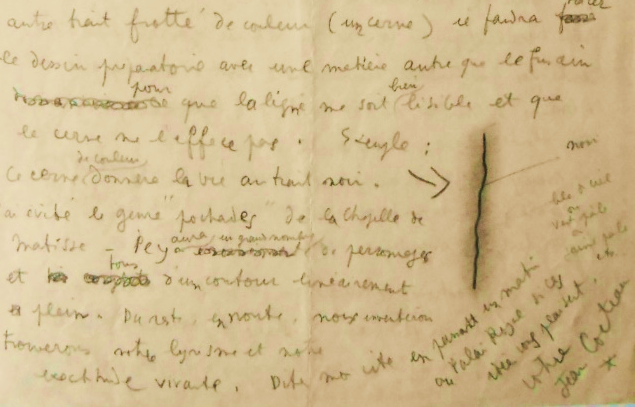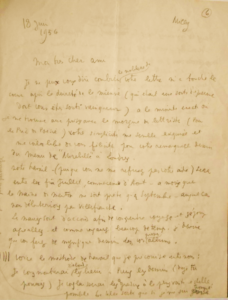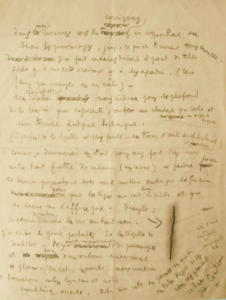Jean Cocteau (1889-1963). Autograph letter signed « Jean Cocteau », Milly, 18 juin 1956, to « mon très cher ami » [the painter Jean-Paul Brusset]. 2 pp. in-4° in pencil.
In 1955, the painter Jean-Paul Brusset (1909-1985) settled on the Côte d’Azur, working with ceramics in Vallauris; he inaugurated the Maeght Foundation in Saint-Paul de Vence. Jean Cocteau asked him to help decorate the frescoes in the chapel of Saint-Pierre in Villefranche-sur-Mer and the wedding hall at Menton Town Hall.
Exceptional letter about their collaboration
Cocteau explains how he organised his work, how he worked and shared his tasks, as well as his line technique.
Mon très cher ami
Je ne peux vous dire combien la noblesse de votre lettre m’a touché le cœur après la dureté de la mienne (qui était une sorte d’épreuve dont vous êtes sorti vainqueur) [;] a la minute exacte où je me trouve aux prises avec la morgue de lettristes (pour le Prix de Poésie) votre simplicité me semble exquise et me voilà libre de vous féliciter pour votre remarquable dessin du menu de “Mirabelle“ à Londres. [I can’t tell you how much the nobility of your letter has touched my heart after the harshness of mine (which was a kind of test from which you emerged the winner) [;] at the very minute when I am grappling with the morgue of the Lettrists (for the Poetry Prize) your simplicity seems exquisite to me and I am free to congratulate you on your remarkable drawing of the menu for “Mirabelle” in London.]
Notre travail – (puisque vous ne me refusez pas votre aide) sera entre la fin Juillet, commencement d’Août – à moins que la mairie de Menton ne soit prête qu’en Septembre – auquel cas nous débuterions par Villefranche. [Our work – (since you won’t refuse me your help) will be between the end of July and the beginning of August – unless Menton Town Hall isn’t ready until September – in which case we’ll start with Villefranche.]
Les maires sont d’accord afin de vous rendre voyage et séjour agréables – et comme vous aurez beaucoup de temps, je devine que vous ferez de magnifiques dessins dans vos propres albums. [The mayors agree to make your journey and your stay as pleasant as possible – and as you’ll have lots of time, I’m guessing you’ll be doing some wonderful drawings in your own albums.]
IIII Voici la méthode de travail que je préconise entre nous : Je vous montrerai d’abord les lieux. Puis les dessins (déjà très poussés). Je vous laisserai les gradins à la plus vaste échelle possible – je n’aime pas les “petits personnages“ – de telle sorte que si je me suis trompé dans les mes mesures vous les réparerez corrigerez en rapprochant au besoin les personnages, jusqu’à ce qu’ils tiennent tous ensemble dans le décor. J’ai fait certains détails à part de telle sorte qu’il ne reste vraiment qu’à les agrandir. (Une fleur par exemple ou un œil) – Un spécialiste italien vous aidera pour le plafond de la mairie qui représente, outre un cheval qui vole et un géni un ange en loques, une terrible fatigue technique. (Le plafond de la chapelle est plus facile – en trompe-l’œil architectural et ciel). Comme je dessinerai au trait noir assez fort sur un autre trait frotté de couleur (un cerne) il faudra faire tracer le dessin préparatoire avec une matière autre que le fusain de manière à ce pour que la ligne me soit bien lisible et que le cerne ne l’efface pas. Il illustre son propos d’un petit schéma en « exemple » montrant le trait « noir » au centre d’un cerne « bleu de ciel ou vert pâle ou jaune pâle etc ». Ce cerne de couleur donnera la vie au trait noir. J’ai évité le genre “pochades“ de la chapelle de Matisse. Il y a énormément aura un grand nombre de personnages et tous d’un contour linéairement plein. Du reste, en route, nous inventerons et trouverons notre lyrisme et notre exactitude vivante. Dites moi vite en passant un matin au Palais Royal si ces idées vous plaisent. [IIII Here is the working method I recommend between us: First I’ll show you the locations. Then the drawings (which are already very advanced). I’ll leave you the bleachers at the largest scale possible – I don’t like “small characters” – so that if I’ve made a mistake in my measurements you can correct them by moving the characters closer together if necessary, until they all fit together in the scenery. I’ve done some details separately so that all that’s really left to do is to enlarge them (a flower, for example, or an eye) – An Italian specialist will help you with the ceiling of the town hall, which, in addition to a flying horse and a ragged angel, represents a terrible technical fatigue (the ceiling of the chapel is easier – in architectural trompe-l’oeil and sky). As I’ll be drawing with a fairly strong black line over another line rubbed with colour (a hoop), I’ll have to trace the preparatory drawing with a material other than charcoal so that the line is clearly legible and the hoop doesn’t erase it. He illustrates his point with a small “example” diagram showing the “black” line in the centre of a “sky blue or pale green or pale yellow etc” border. This ring of colour will give life to the black line. I’ve avoided the “stencil” style of Matisse’s chapel. There will be a huge number of characters, all with full linear outlines. Along the way, we’ll be inventing and finding our own lyricism, and I’m sure we’ll find it.]
Votre
Jean Cocteau
After a dig at Matisse and his Rosary chapel in Vence, his flamboyantly poetic and prophetic conclusion is particularly noteworthy: « Along the way, we’ll be inventing and finding our own lyricism, and I’m sure we’ll find it.] » ;he invented what came to be known as the “Menton style”.
At the request of Francis Palmero, Mayor of Menton, Cocteau decorated the town hall’s Salle des Mariages from 1957 to 1958. The inauguration took place on 22 March 1958.
1 300 €


